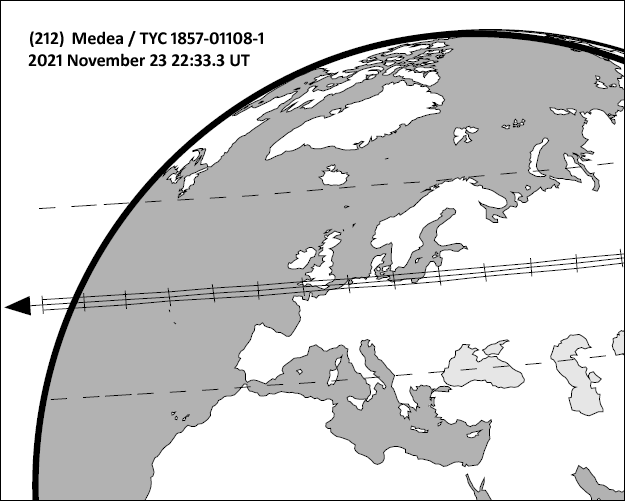Double star unexpectedly detected during occultation by asteroid – a first from the UK
2022 January 29
These results are a very dramatic demonstration of the effectiveness of the occultation method at measuring the intrinsic properties of a double star or occulting body. – R. Miles, Director

Many asteroids are predicted to occult stars each year, but only a tiny fraction of these events are visible from any one location on Earth. One such event involved the main-belt asteroid (212) Medea, which was predicted to occult the magnitude 10.3 star TYC 1857-01108-1,1 in Taurus, on the evening of 2021 Nov 23 (See the 2021 BAA Handbook, p.56).
Philip Denyer was observing from Hornchurch, London that evening using a Celestron C9.25 Schmidt–Cassegrain telescope equipped with a WAT-910HX integrating video camera, when an unusual event was about to unfold. Phil was making a routine observation in the hope of seeing an occultation, which occurs when the light from the star is obstructed by the passage of the asteroid body blocking it for a few seconds. However, it turned out that the star ‘blinked’ not once but twice.
In his initial communication to the Asteroids & Remote Planets Section (ARPS), Phil wrote:
‘I obtained a positive result of (212) Medea on November 23rd. I saw on the monitor a dip two seconds before the predicted time for my location. However I did not notice a second dip on the monitor until the light curve was produced using Tangra software. [In Table 1] are my times and event details as extracted by visual inspection of the light curve (see Figure 2). A quick look at the light curve shows the magnitude drop on second D [‘disappearance’] appears to be about half the level of the first D.’
The first D (predicted time 22:36:31 UT; offset error 2s; max. duration 13.7s; mag. drop 2.1) was followed by a gap of 29.72 seconds and then the second D:
Disapp. (UT) Reapp. (UT) Duration (s)
First D 22.36.28.899 22:36:34.579 5.68
Second D 22:37:04.299 22.37.16.339 12.04
Obtaining a light curve
The ARPS Occultations group recommends the use of video or CMOS cameras to record potentially occulted stars over an interval of a few minutes. The digital recording (in AVI or SER format) should be time-stamped via a dedicated GPS receiver or a computer clock carefully synchronised to Universal Time.2 Event timings can be displayed in Tangra and several stars can be selected for comparison purposes.
The recording of this observation involved the use of a WAT-910HX video camera together with a GPSBOXSPRITE3 time-inserter, a USB video digitiser and VirtualDub video-capture software.
What does the light curve reveal?
Note that the first D–R event did not totally extinguish the star as would normally be expected: some light remained. Then, the second D–R event exhibited a drop in intensity amounting to about half that of the first step-change in brightness.
The rapidly fluctuating light levels are caused by turbulent seeing conditions in our atmosphere and changes in its transparency. Given the short exposure time used, the observed fluctuations are similar to the appearance of stars ‘twinkling’. The effect can be smoothed out to a degree by placing the star slightly out of focus.
The observation by Phil is a very clear-cut and dramatic demonstration of each component of the double star passing along separate chords, traversing behind the solid body of the asteroid. Sadly, no other observer has sent in a report of this occultation, either positive or negative.
Reporting
An extract of a preliminary report on the Euraster website maintained by Eric Frappa is shown below (Figure 3).3 Eric helped with the analysis and he details the magnitude of the stellar components as A: 10.8 and B: 11.5, obtained using the Python program PyOTE.4
Given the motion of the asteroid at the time amounted to 0.47arcsec/min in position angle 265°, we suggest an approximate separation of 0.3 arcseconds between components A and B of the double. Surprisingly, the apparent double star is not included in the Washington Double Star Catalogue and could represent a new detection. Further investigation is suggested.
Phil Denyer, Tim Haymes & Richard Miles, Asteroids & Remote Planets Section
Notes & references
1 Prediction: bit.ly/34ZQt7l. The star is also known as UCAC4 593-016335.
2 Haymes T., ‘Observing asteroid occultations with digital cameras’: britastro.org/node/16423
3 Euraster: bit.ly/3qzxMja
4 PyOTE is an occultation timing extraction utility, written by Bob Anderson of the International Occultation Timing Association (IOTA).
https://britastro.org/wp-content/uploads/2022/01/light-curve.PNG
https://britastro.org/wp-content/uploads/2022/01/text.PNG
https://britastro.org/wp-content/uploads/2022/02/light-curve.PNG
| The British Astronomical Association supports amateur astronomers around the UK and the rest of the world. Find out more about the BAA or join us. |
